Лексикология как наука.pptx
- Количество слайдов: 10
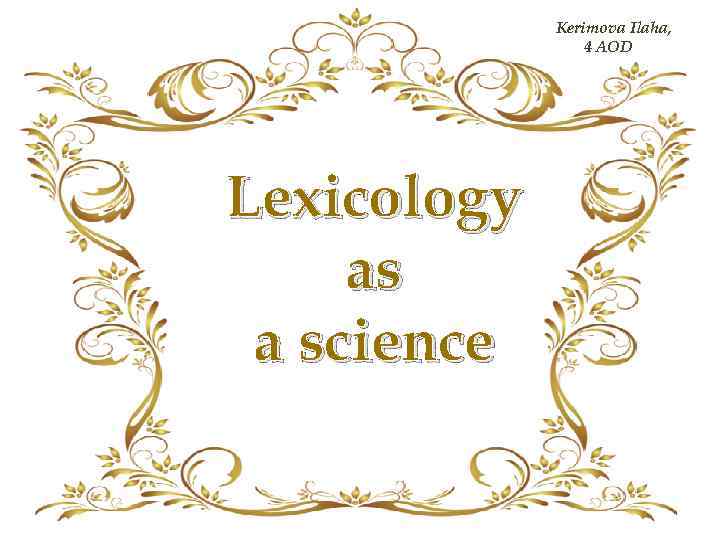 Kerimova Ilaha, 4 AOD Lexicology as a science
Kerimova Ilaha, 4 AOD Lexicology as a science
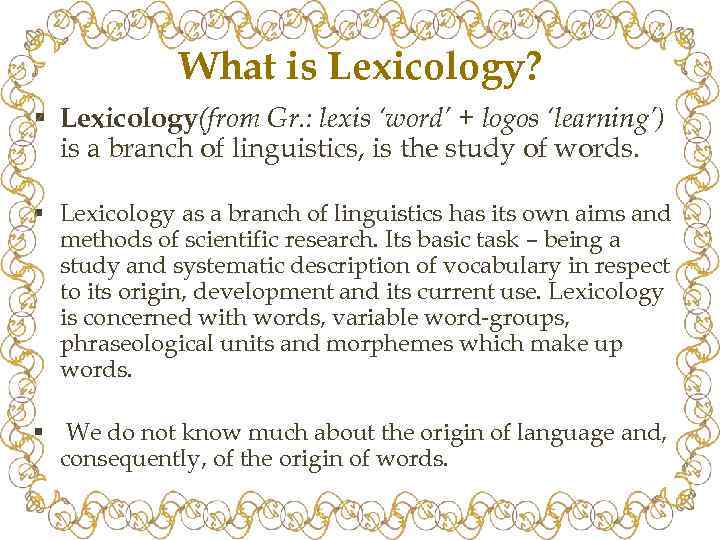 What is Lexicology? § Lexicology(from Gr. : lexis ‘word’ + logos ‘learning’) is a branch of linguistics, is the study of words. § Lexicology as a branch of linguistics has its own aims and methods of scientific research. Its basic task – being a study and systematic description of vocabulary in respect to its origin, development and its current use. Lexicology is concerned with words, variable word-groups, phraseological units and morphemes which make up words. § We do not know much about the origin of language and, consequently, of the origin of words.
What is Lexicology? § Lexicology(from Gr. : lexis ‘word’ + logos ‘learning’) is a branch of linguistics, is the study of words. § Lexicology as a branch of linguistics has its own aims and methods of scientific research. Its basic task – being a study and systematic description of vocabulary in respect to its origin, development and its current use. Lexicology is concerned with words, variable word-groups, phraseological units and morphemes which make up words. § We do not know much about the origin of language and, consequently, of the origin of words.
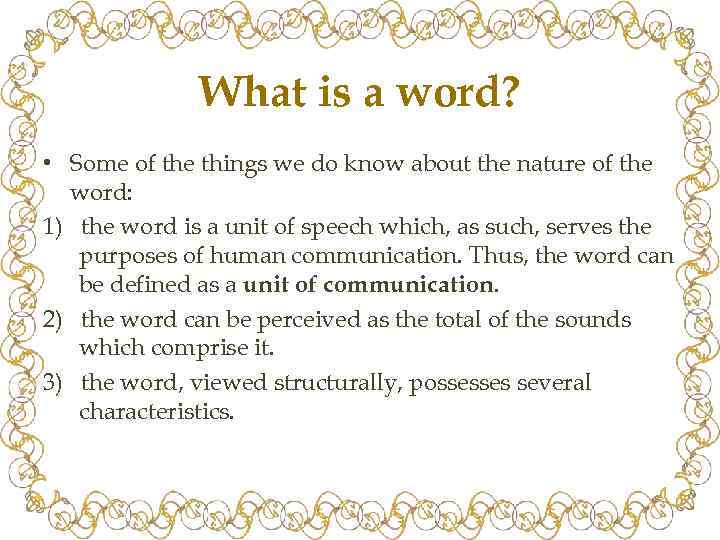 What is a word? • Some of the things we do know about the nature of the word: 1) the word is a unit of speech which, as such, serves the purposes of human communication. Thus, the word can be defined as a unit of communication. 2) the word can be perceived as the total of the sounds which comprise it. 3) the word, viewed structurally, possesses several characteristics.
What is a word? • Some of the things we do know about the nature of the word: 1) the word is a unit of speech which, as such, serves the purposes of human communication. Thus, the word can be defined as a unit of communication. 2) the word can be perceived as the total of the sounds which comprise it. 3) the word, viewed structurally, possesses several characteristics.
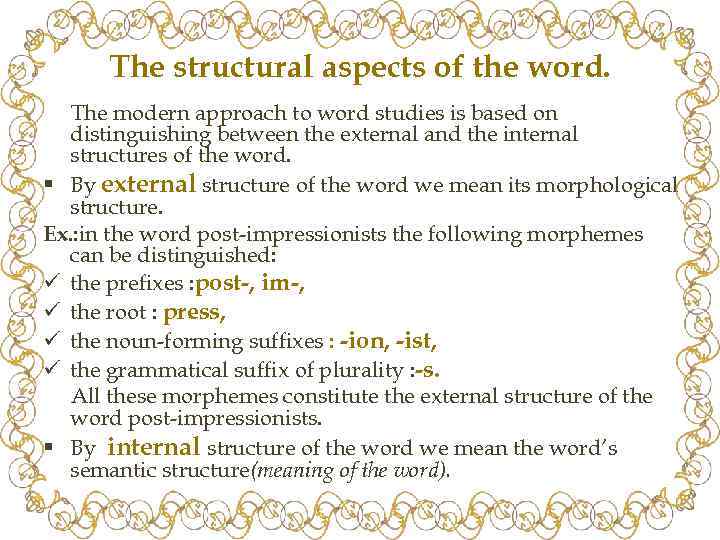 The structural aspects of the word. The modern approach to word studies is based on distinguishing between the external and the internal structures of the word. § By external structure of the word we mean its morphological structure. Ex. : in the word post-impressionists the following morphemes can be distinguished: ü the prefixes : post-, im-, ü the root : press, ü the noun-forming suffixes : -ion, -ist, ü the grammatical suffix of plurality : -s. All these morphemes constitute the external structure of the word post-impressionists. § By internal structure of the word we mean the word’s semantic structure(meaning of the word).
The structural aspects of the word. The modern approach to word studies is based on distinguishing between the external and the internal structures of the word. § By external structure of the word we mean its morphological structure. Ex. : in the word post-impressionists the following morphemes can be distinguished: ü the prefixes : post-, im-, ü the root : press, ü the noun-forming suffixes : -ion, -ist, ü the grammatical suffix of plurality : -s. All these morphemes constitute the external structure of the word post-impressionists. § By internal structure of the word we mean the word’s semantic structure(meaning of the word).
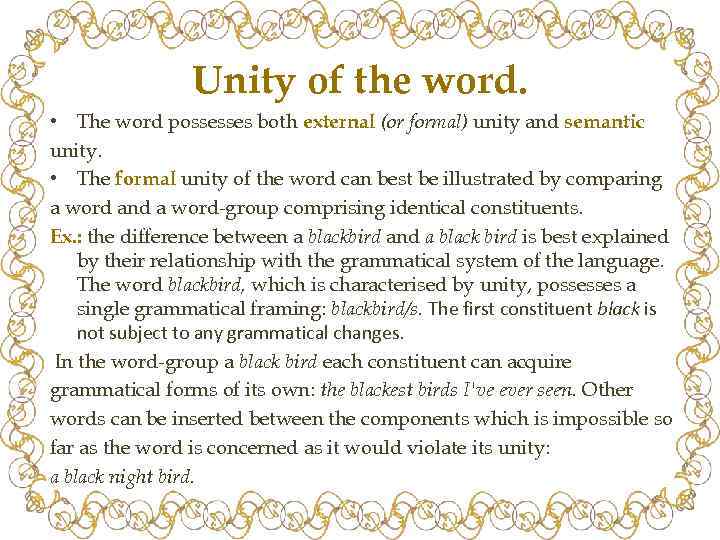 Unity of the word. • The word possesses both external (or formal) unity and semantic unity. • The formal unity of the word can best be illustrated by comparing a word and a word-group comprising identical constituents. Ex. : the difference between a blackbird and a black bird is best explained by their relationship with the grammatical system of the language. The word blackbird, which is characterised by unity, possesses a single grammatical framing: blackbird/s. The first constituent black is not subject to any grammatical changes. In the word-group a black bird each constituent can acquire grammatical forms of its own: the blackest birds I've ever seen. Other words can be inserted between the components which is impossible so far as the word is concerned as it would violate its unity: a black night bird.
Unity of the word. • The word possesses both external (or formal) unity and semantic unity. • The formal unity of the word can best be illustrated by comparing a word and a word-group comprising identical constituents. Ex. : the difference between a blackbird and a black bird is best explained by their relationship with the grammatical system of the language. The word blackbird, which is characterised by unity, possesses a single grammatical framing: blackbird/s. The first constituent black is not subject to any grammatical changes. In the word-group a black bird each constituent can acquire grammatical forms of its own: the blackest birds I've ever seen. Other words can be inserted between the components which is impossible so far as the word is concerned as it would violate its unity: a black night bird.
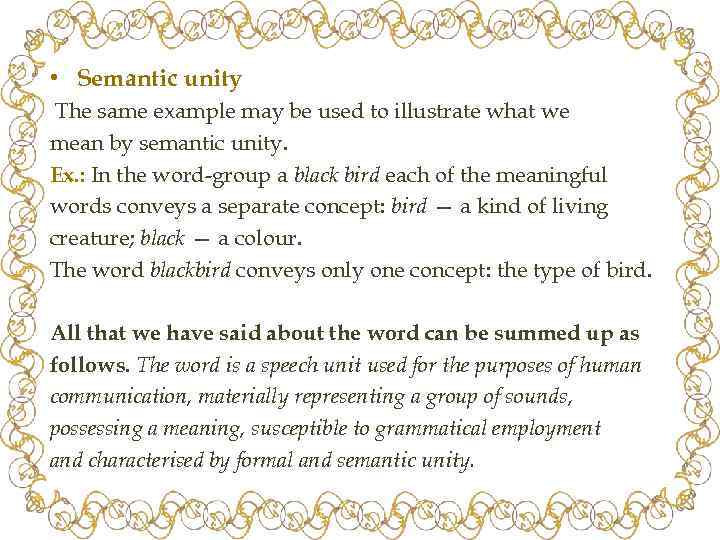 • Semantic unity The same example may be used to illustrate what we mean by semantic unity. Ex. : In the word-group a black bird each of the meaningful words conveys a separate concept: bird — a kind of living creature; black — a colour. The word blackbird conveys only one concept: the type of bird. All that we have said about the word can be summed up as follows. The word is a speech unit used for the purposes of human communication, materially representing a group of sounds, possessing a meaning, susceptible to grammatical employment and characterised by formal and semantic unity.
• Semantic unity The same example may be used to illustrate what we mean by semantic unity. Ex. : In the word-group a black bird each of the meaningful words conveys a separate concept: bird — a kind of living creature; black — a colour. The word blackbird conveys only one concept: the type of bird. All that we have said about the word can be summed up as follows. The word is a speech unit used for the purposes of human communication, materially representing a group of sounds, possessing a meaning, susceptible to grammatical employment and characterised by formal and semantic unity.
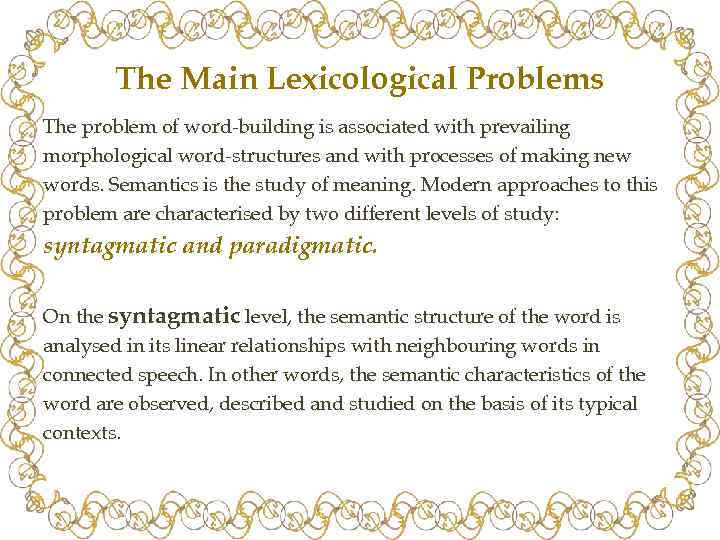 The Main Lexicological Problems The problem of word-building is associated with prevailing morphological word-structures and with processes of making new words. Semantics is the study of meaning. Modern approaches to this problem are characterised by two different levels of study: syntagmatic and paradigmatic. On the syntagmatic level, the semantic structure of the word is analysed in its linear relationships with neighbouring words in connected speech. In other words, the semantic characteristics of the word are observed, described and studied on the basis of its typical contexts.
The Main Lexicological Problems The problem of word-building is associated with prevailing morphological word-structures and with processes of making new words. Semantics is the study of meaning. Modern approaches to this problem are characterised by two different levels of study: syntagmatic and paradigmatic. On the syntagmatic level, the semantic structure of the word is analysed in its linear relationships with neighbouring words in connected speech. In other words, the semantic characteristics of the word are observed, described and studied on the basis of its typical contexts.
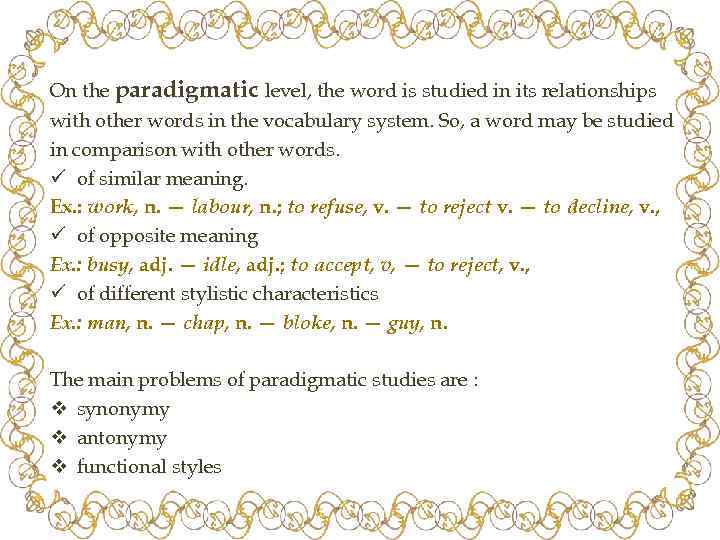 On the paradigmatic level, the word is studied in its relationships with other words in the vocabulary system. So, a word may be studied in comparison with other words. ü of similar meaning. Ex. : work, n. — labour, n. ; to refuse, v. — to reject v. — to decline, v. , ü of opposite meaning Ex. : busy, adj. — idle, adj. ; to accept, v, — to reject, v. , ü of different stylistic characteristics Ex. : man, n. — chap, n. — bloke, n. — guy, n. The main problems of paradigmatic studies are : v synonymy v antonymy v functional styles
On the paradigmatic level, the word is studied in its relationships with other words in the vocabulary system. So, a word may be studied in comparison with other words. ü of similar meaning. Ex. : work, n. — labour, n. ; to refuse, v. — to reject v. — to decline, v. , ü of opposite meaning Ex. : busy, adj. — idle, adj. ; to accept, v, — to reject, v. , ü of different stylistic characteristics Ex. : man, n. — chap, n. — bloke, n. — guy, n. The main problems of paradigmatic studies are : v synonymy v antonymy v functional styles
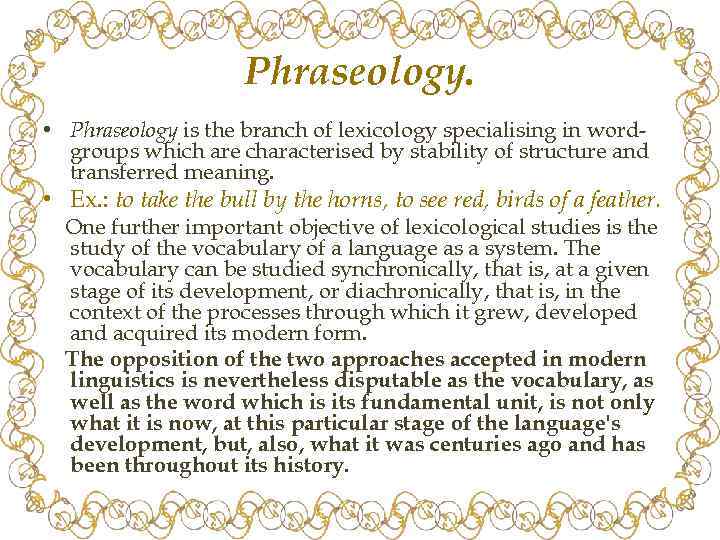 Phraseology. • Phraseology is the branch of lexicology specialising in wordgroups which are characterised by stability of structure and transferred meaning. • Ex. : to take the bull by the horns, to see red, birds of a feather. One further important objective of lexicological studies is the study of the vocabulary of a language as a system. The vocabulary can be studied synchronically, that is, at a given stage of its development, or diachronically, that is, in the context of the processes through which it grew, developed and acquired its modern form. The opposition of the two approaches accepted in modern linguistics is nevertheless disputable as the vocabulary, as well as the word which is its fundamental unit, is not only what it is now, at this particular stage of the language's development, but, also, what it was centuries ago and has been throughout its history.
Phraseology. • Phraseology is the branch of lexicology specialising in wordgroups which are characterised by stability of structure and transferred meaning. • Ex. : to take the bull by the horns, to see red, birds of a feather. One further important objective of lexicological studies is the study of the vocabulary of a language as a system. The vocabulary can be studied synchronically, that is, at a given stage of its development, or diachronically, that is, in the context of the processes through which it grew, developed and acquired its modern form. The opposition of the two approaches accepted in modern linguistics is nevertheless disputable as the vocabulary, as well as the word which is its fundamental unit, is not only what it is now, at this particular stage of the language's development, but, also, what it was centuries ago and has been throughout its history.
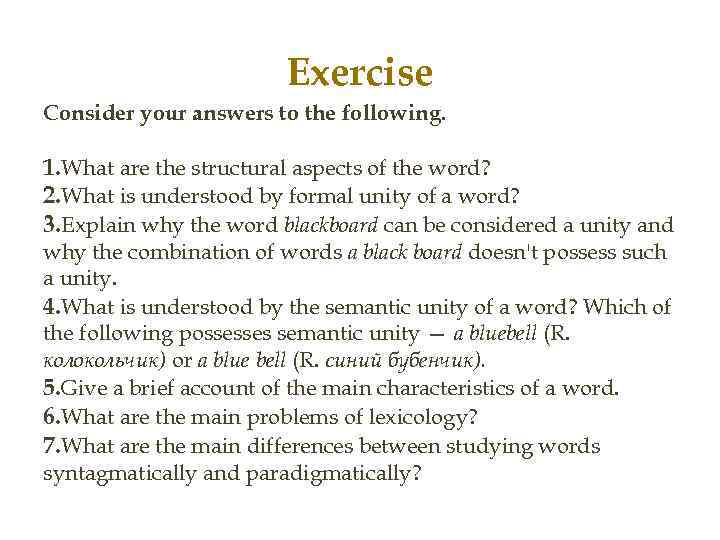 Exercise Consider your answers to the following. 1. What are the structural aspects of the word? 2. What is understood by formal unity of a word? 3. Explain why the word blackboard can be considered a unity and why the combination of words a black board doesn't possess such a unity. 4. What is understood by the semantic unity of a word? Which of the following possesses semantic unity — a bluebell (R. колокольчик) or a blue bell (R. синий бубенчик). 5. Give a brief account of the main characteristics of a word. 6. What are the main problems of lexicology? 7. What are the main differences between studying words syntagmatically and paradigmatically?
Exercise Consider your answers to the following. 1. What are the structural aspects of the word? 2. What is understood by formal unity of a word? 3. Explain why the word blackboard can be considered a unity and why the combination of words a black board doesn't possess such a unity. 4. What is understood by the semantic unity of a word? Which of the following possesses semantic unity — a bluebell (R. колокольчик) or a blue bell (R. синий бубенчик). 5. Give a brief account of the main characteristics of a word. 6. What are the main problems of lexicology? 7. What are the main differences between studying words syntagmatically and paradigmatically?


